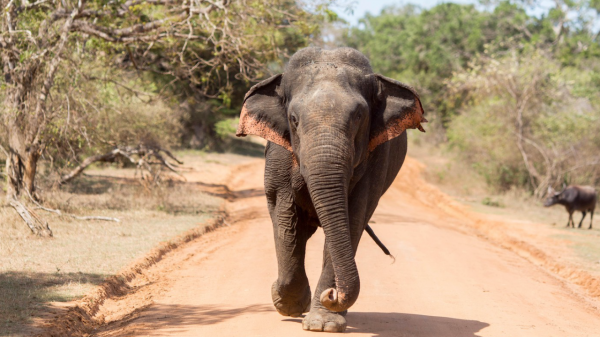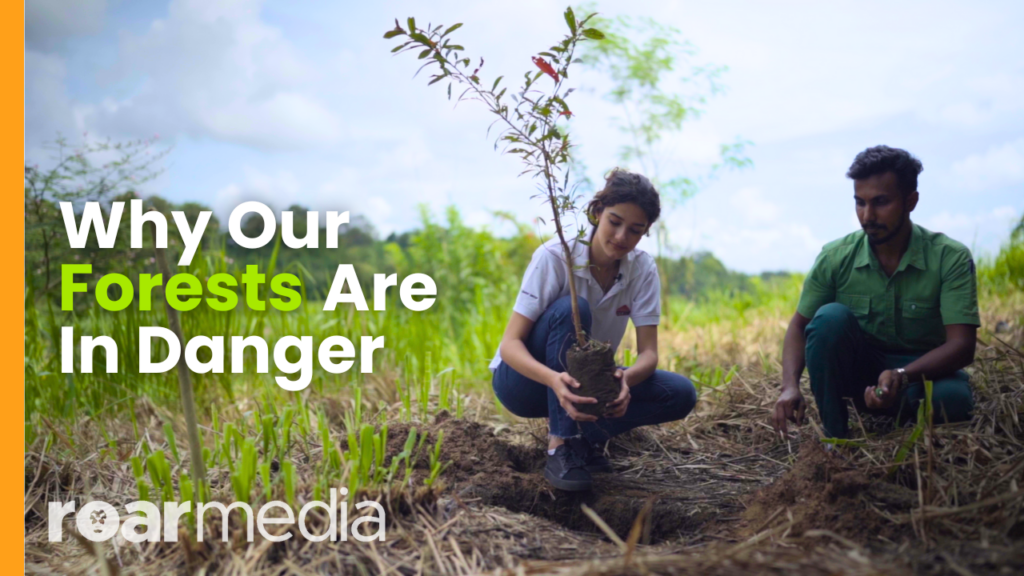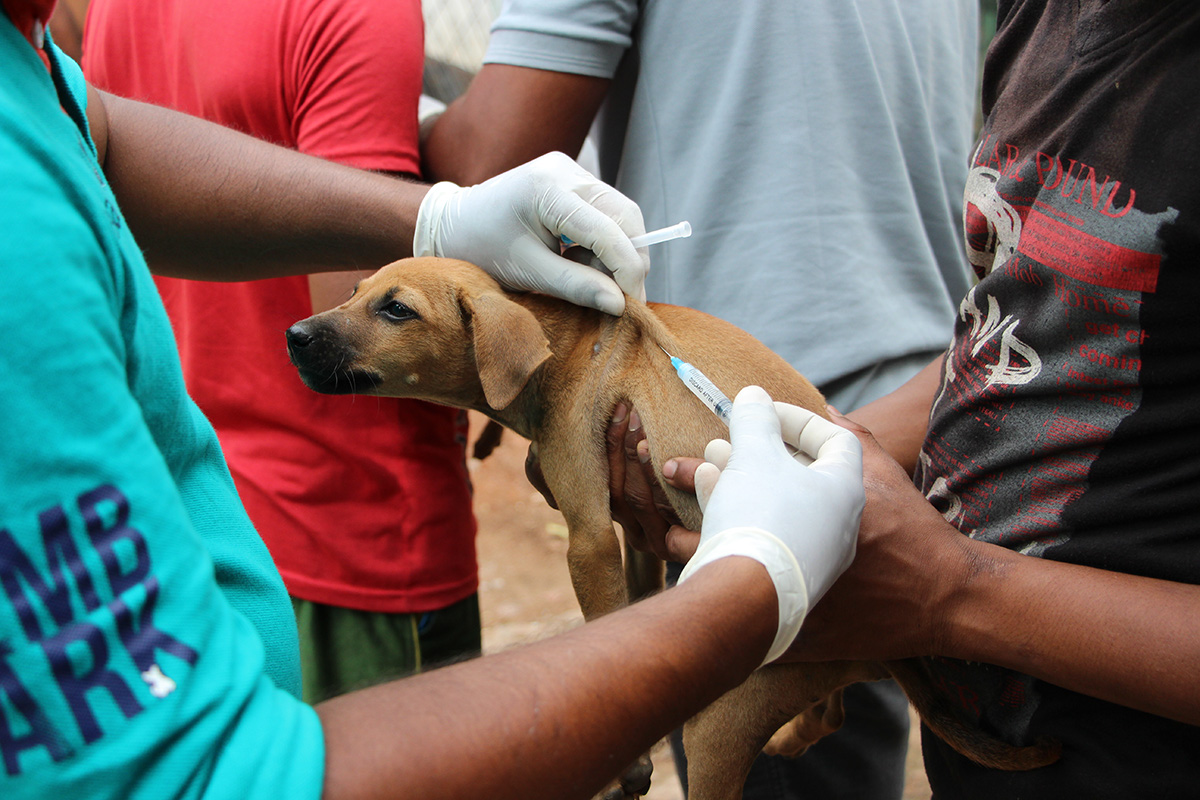
Before the floods occurred, the Government’s spotlight had been trained on the country’s street pooches, and animal welfare organisations (AWOs), activists and animal lovers had been up in arms in their defense. With a hundred different claims, rebuttals, and proposals flying back and forth in the news and social media, it has been pretty hard to sift through all that and secure an accurate idea of what’s going on. Keeping this in mind, we decided to break things down a little and present the situation as it is.
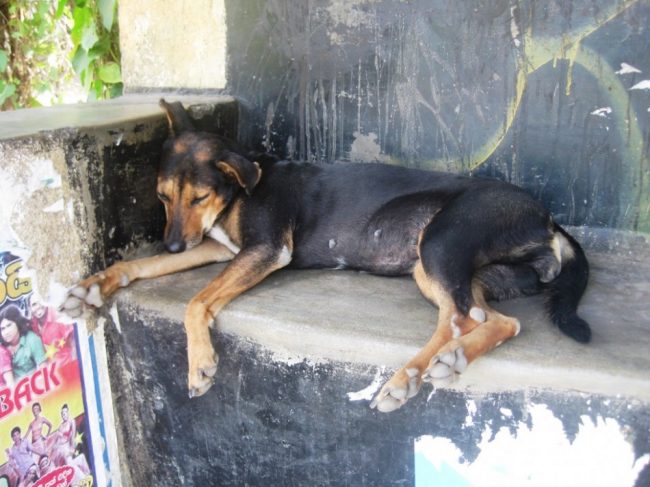
Seeing a dog snoozing on a street corner is, sadly, not an unusual sight in Sri Lanka. Image credit: dogstarfoundation.com
It all began when the Government announced its intention to roll out a policy concerning the country’s stray dogs. According to media reports, Minister of Local Government and Provincial Councils, Faiszer Musthapha, had been requested by the cabinet to present a proposal on managing the stray dog “menace” – and Sri Lanka’s AWOs are finding the announcement pretty ominous.
The Government cites several reasons for this sudden focus on the island’s canine strays. Complaints have allegedly been made to a number of local councils about stray dogs in public places. Rabies, while drastically on the decline, still exists (with 24 deaths in 2015), and needs to be completely eliminated. Sri Lanka also seems to amass a large number of dog bite cases, which costs the Government hundreds of millions in treatment for dog-bite victims each year .
Normally, a move like this shouldn’t be a cause for concern ‒ after all, the policy objectives are noble ones, and these issues do need solving ‒ but Sri Lankan AWOs, activists, and animal lovers are anxious for a number of reasons. For instance, many claim the Minister’s continuous reference to a 500,000 stray dog population in the country to be inaccurate and unfounded ‒ something which does not bode well. If the Government can’t get simple statistics straight, how can they fully address the problem?
“As far as we are aware, no comprehensive dog count has been performed on the entire island,” said Otara Gunewardene, founder of the Otara Foundation and Embark. Speaking to Roar, she explained that different entities working around the island will have numbers for the areas they work in, but despite surveys, there is no uniform system that organisations use to keep track of the stray dog population.
When it comes to statistics, another complication that arises is the fact that the distinction between street, community, and owned dogs is not always clear. Even if a comprehensive count is performed, it would be difficult to pinpoint which category each dog belongs in.
Another reason for alarm is the Government’s suggestion to remove stray dogs from public areas, an act which, according to AWOs, will not only be ineffective for population control but also detrimental to the well-being of the dogs. However, the biggest cause for anxiety is the fact that the Government is re-evaluating the situation at all, when the best solution available (the internationally accepted Catch-Neuter-Vaccinate-Release method) is already being implemented.
Who Is To Blame For The Number Of Canine Strays On Our Streets?
Well, it certainly is not the dogs. As it turns out, people’s actions are to be blamed for aggravating the stray dog situation.

A Shih Tzu anyone? Excessive breeding and increased demand for pedigreed dogs make it difficult for vaccinated and sterilised puppies to find homes. Image credit: Wikipedia.org
Some contributory factors include:
- Dumping unwanted puppies in public places.
How can we possibly keep dogs off the street when unsavoury people keep sneaking in more of them right back? Not only is this cruel and inconsiderate, but it also undoes all the hard work AWOs and the Government has done to curb the problem.
- Dumping garbage on the streets.
We may cover our noses and run past them, but all those garbage dumps are like dinner buffets to hungry stray dogs. On top of that, councils sometimes fail to systematically remove garbage from streets. It is only natural that stray dogs will congregate in such places. After all, if you knew of a place that regularly offers fantastic free food, wouldn’t you rush over there and stay there?
- Excessive breeding of pedigreed dogs.
Why have a cute mongrel puppy for free, when we can spend thousands on an expensive Shih Tzu pup instead? That train of thought makes little sense, but strangely, people seem to think that way anyway. An increasing number of individuals prefer splurging on some expensive pure-bred dog with a fancy name, rather than give a home to a homeless mongrel puppy, making it even harder to remove stray pups and dogs from the streets. This unregulated dog breeding industry is one of the main factors authorities should be focusing on, since many of these dogs actually end up on the streets.
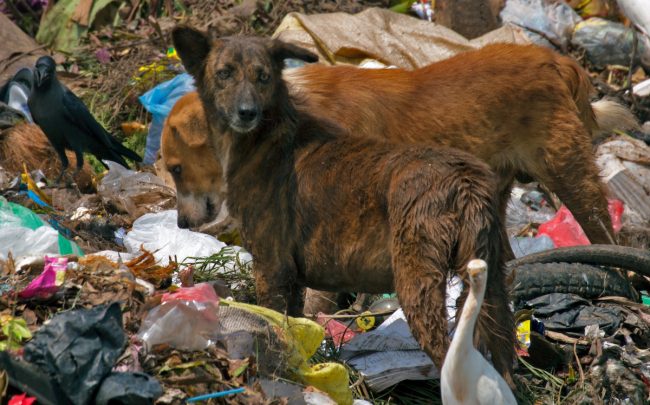
What’s a smelly rubbish dump to us is a source of food for stray dogs. Caption: dogstar.org
How Have We Dealt With Stray Dogs Thus Far?
Before Mahinda Rajapaksa implemented the No Kill policy in 2006, the 1897 Rabies Ordinance allowed stray dogs to be rounded up and gassed; a horrifying and painful end for thousands of innocent animals. However, not only was this method inhumane and cruel, but it also proved to be ineffective in controlling rabies.
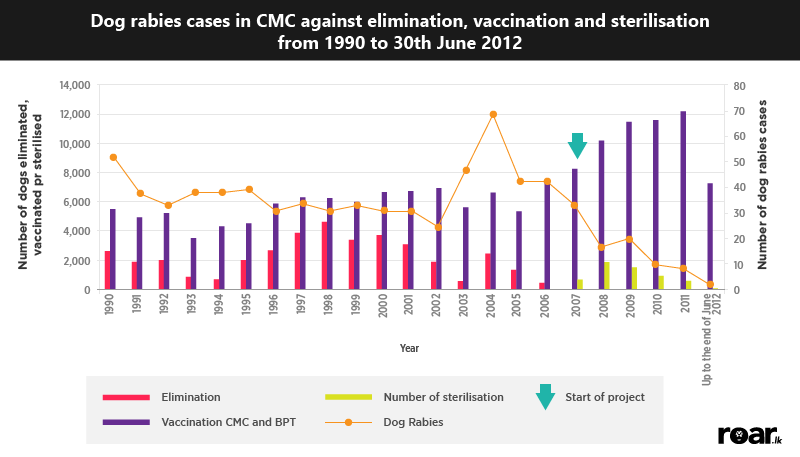
Statistics clearly show that culling dogs made no significant difference in the number of rabies cases. However, the number of dog rabies cases dramatically nosedived after the implementation of the No Kill Policy and increased number of vaccinations and sterilisations. Info: wsava.org (Project by Blue Paw Trust in collaboration with CMC and WSPA).
Thankfully, under the No Kill Policy, the Sri Lankan Government replaced the culling method with more effective CNVR (Catch-Neuter-Vaccinate-Release) method, which has since then resulted in a dramatic drop in human rabies deaths. AWOs like Embark, Dogstar, and Blue Paw Trust hugely reinforce these programmes with dynamic CNVR and adoption drives of their own, while sometimes collaborating with Government programmes to get even better results.
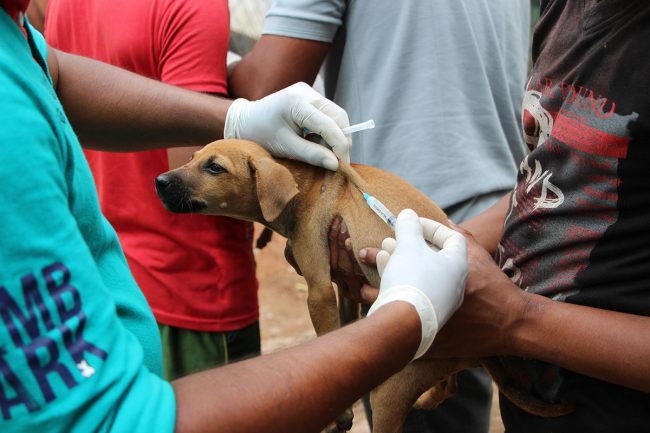
Vaccinating a stray pooch. Image credit: Embarkpassion.com
However, the authorities have turned to dubious techniques in the past, which is probably the reason why AWOs are voicing their concern now. One such method which was occasionally resorted to, stems from the simple strategy of moving an annoyance elsewhere: basically, relocation. This was most significantly done during the Colombo beautification project prior to the CHOGM 2013, when the Government rounded up Colombo’s stray dogs and either moved them to remote areas or temporarily confined them in shelters, in spite of the howls of protest drawn from Sri Lankan AWOs. Not only does relocation spell unhappiness for the dog, but it also tends to be unwise in terms of population control. When sterilised and vaccinated dogs are removed from their territory, the existing herd immunity is broken. This leave gaps for other dogs, which are neither sterilised nor vaccinated, to enter the area. In this way, all the money, energy and time spent on neutering and vaccinating the dogs go to waste, and the situation is back to square one.
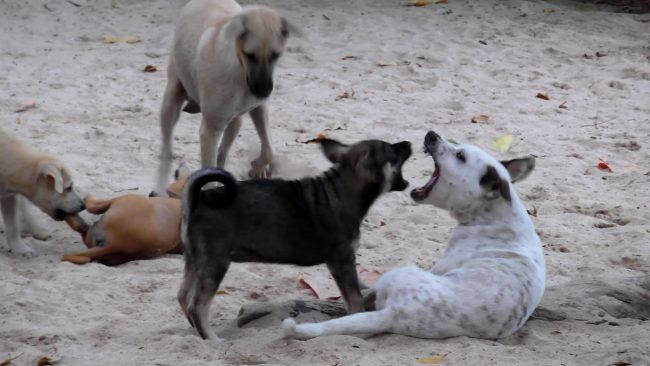
Dogs dumped in unfamiliar areas tend to be vulnerable to starvation and attack from other dogs from the area. Image credit: YouTube/asoke11
The government once also made a catastrophic attempt to run an animal shelter for stray dogs in Nellikulama, Anuradhapura. With around 400 dogs living in horrifying conditions, the establishment was such an utter disaster that it was forced to close down shortly after being established, at the cost of millions of rupees and many lives of innocent dogs. In the end, AWOs had to intervene to rescue the surviving dogs left to die amidst squalor and disease.
What Is The Best Solution To The Problem?
AWOs are convinced that a dynamic CNVR (Catch-Neuter-Vaccinate-Return) method is the most humane and effective means of controlling the stray dog population and making Sri Lanka rabies free. Not only is this method WHO approved and internationally accepted, but it has also produced considerable results in Sri Lanka.
CNVR is pegged as a slow process as it is not as visually satisfying to authorities as removing dogs permanently. Still, the numbers speak for themselves – there has been a significant decrease in the number of human rabies-related deaths since the CNVR-only method was brought in. Looking at the situation logically, the most rational course of action here would be to manage and monitor the factors that actually impede this method.
“CNVR is a humane and effective way of handling the issue of overpopulation and the spread of rabies, benefiting both the people and the dogs with a long-term solution,” says Otara Gunewardene, speaking of CNVR and the factors that hinder it. “We are confident that if these issues can be regulated and the necessary policies implemented ‒ including the Animal Welfare Bill – then a comprehensive CNVR method would bring faster and better progress than ever before.”
However, AWOs stress on the fact that the CNVR method is ineffective without the “R” factor of it ‒ releasing or returning animals to the locations from which they were captured. “The theory behind this is quite specific,” explains Gunewardene. “The already vaccinated street dogs need to stay in an area in order to keep rabies from entering a rabies-free zone.”
According to Gunewardene, killing animals, relocating or putting dogs in shelters are not sustainable solutions in the long term. Dog shelters, for example, need space, food, and manpower, all of which require consistent funding, and also take the responsibility away from the public, encouraging more people to dump animals, while discouraging sterilisation. Additionally, contagious diseases and parasites such as ticks are likely to spread rapidly among animals living in such close proximity, resulting in the need for constant medical attention, which again, requires funding. “It requires a huge commitment for it to be done in a manner that ensures the good welfare of the dogs and the people living around these shelters,” says Gunewardene.
She also adds that Blue Paw Trust procedures like creating dog managed zones and efficient garbage disposal would go a long way in controlling and maintaining good health standards of both the street animals and the communities they live in.
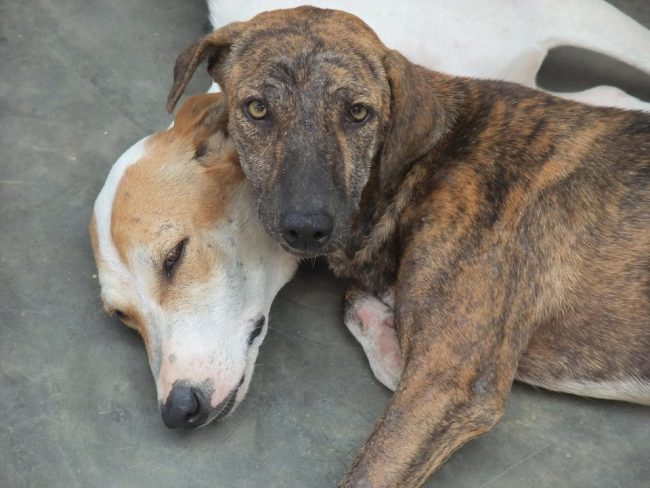
With the Government’s spotlight focusing on them, what fate awaits our street pooches? Credits: Animal SOS Sri Lanka
To his credit though, not only has Minister Faiszer Musthapha stressed that he is looking for a humane solution, but he also does seem to be listening to the suggestions, objections, and recommendations offered by various animal welfare organisations and activists in Sri Lanka. Whether he actually acts on them, however, remains to be seen.
While the year 2015 has seen 24 human deaths due to rabies, it has also amassed a whopping 2,772 deaths due to road accidents, 3,059 to suicide and over 50 deaths due to dengue. All these facts beg the questions: hasn’t the Government got more important issues to focus on? If CNVR has been producing such visibly significant results over the years, why does the Government feel a sudden need to re-evaluate the situation? What is the point of doing a drastic reassessment of a solution which is already working so well, when there are a hundred other issues in the country which are currently in need of attention? Here’s hoping that the authorities make a decision with careful and unbiased consideration of the situation, before creating a problem where there isn’t one.
Featured image courtesy: Embarkpassion.com




